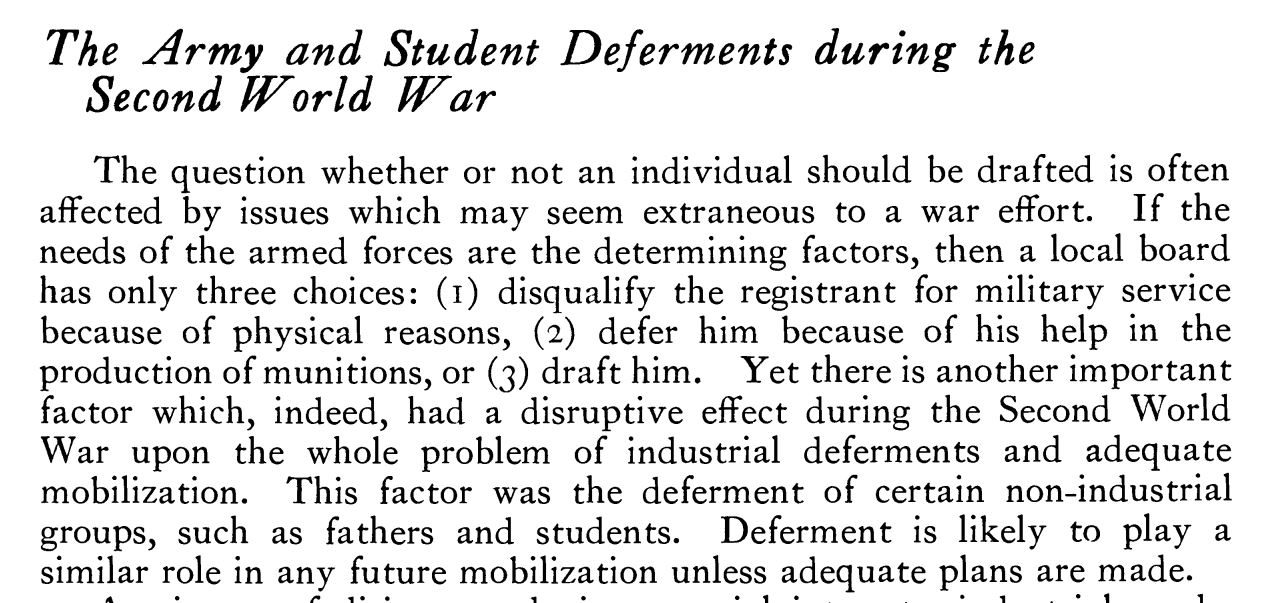Author(s): Albert A. Blum
Source: The Journal of Higher Education, Jan., 1960, Vol. 31, No. 1 (Jan., 1960), pp. 41- 45
Page Count: 6
Published by: Taylor & Francis, Ltd.
Stable URL: https://www.jstor.org/stable/1977574
Summary
The article delves into the intricate policies and debates surrounding the deferment of college students during World War II, highlighting the tension between military manpower needs and the preservation of educational resources for future societal and war contributions.
Background and Context
The article begins by framing the issue of drafting individuals, noting that decisions often extend beyond mere military needs to include extraneous factors. It outlines three primary choices for local draft boards: disqualifying registrants for physical reasons, deferring them for contributions to munitions production, or drafting them. However, a significant disruptive factor during World War II was the deferment of non-industrial groups, such as fathers and students, which impacted industrial deferments and mobilization efforts. The article suggests that without adequate planning, deferment could play a similar role in future mobilizations.
The Selective Training and Service Act, a key legislative framework, included a provision allowing college students to be deferred until the end of the academic year. More crucially, Section 5 of the law empowered the President to defer men whose employment or activities were necessary for national health, safety, or interest, which the Selective Service System interpreted to include students, not as students per se, but for their prospective war contributions.
Policy Details and Implementation
The deferment regulation for students mirrored that for industrial deferments, governed by Local Board Memorandum 115, Part VIII, which dealt with "necessary men in training and preparation." To qualify, registrants had to be training for a "critical occupation" with a personnel shortage, and for college students, this meant completing at least two academic years. This policy reflected a pragmatic approach, recognizing the need for skilled professionals like doctors and engineers, especially critical during wartime.
However, the article humanizes this policy by describing the internal struggle on college campuses, particularly after the draft was extended to include eighteen-year-olds. Deans worried about the survival of higher education and the postwar world without college-trained men, while local draft boards and Army representatives questioned why talented students should be exempt when others were drafted. Students themselves were caught in confusion, urged to enlist, stay in school for officer training, or criticized as draft-dodgers, reflecting the policy's ambiguity during 1942 and 1943.
Names
The article highlights several key figures involved in these debates, each with distinct roles and perspectives:
Dixon Ryan Fox, president of Union College and a historian, wrote to Undersecretary of War Robert P. Paterson in early 1941, lamenting the financial and intellectual impact of drafting students, emphasizing the need for part-time military training to preserve future leadership.
Hiram C. Todd, another Trustee of Union College, supported Fox, arguing that well-educated men were needed as officer material and for postwar governance.
Robert P. Paterson, Undersecretary of War and an alumnus and Trustee of Union College, rejected part-time training as undemocratic and ineffective, advocating that college students serve first, not last, and opposing special treatment before Pearl Harbor. His views were detailed in a ten-page memorandum to Secretary of War Henry Stimson on September 24, 1942, urging a shift from encouraging students to remain in college.
Lewis B. Hershey, Major General and head of the Selective Service System, also opposed group deferment, criticizing the Enlisted Reserve Corps (ERC) program as undemocratic and economically biased, suggesting it attracted those avoiding service. He quoted a headmaster to draw parallels with Civil War draft avoidance, leading to Secretary Stimson's decision to call ERC students to active duty by February 1943.
Henry Stimson, Secretary of War, received Paterson's recommendations and supported drafting college students, except for medical students, due to steady Army needs for doctors.
Brehon Somervell, General and head of the Army Service Force, was directed to prepare the Army Specialized Training Program (ASTP) following Paterson's memorandum, aiming to train college-level men for future Army needs and mitigate resistance from industry and colleges to drafting students. The ASTP, approved in June 1943, also involved transferring "limited-service" personnel to war industries.
Paul McNutt, head of the War Manpower Commission (WMC), issued Occupational Bulletin No. 11 on March 1, 1943, providing for deferment of competent students in scientific or engineering fields until July 1, 1945, despite strong objections from Paterson and the War Department, which saw it as temporary and not a permanent policy.
George Marshall, General and Army Chief of Staff, objected to proposals for deferring high-school students aged eighteen and nineteen until the end of the academic year, emphasizing the Army's need for young men who could absorb training and withstand combat, though he did not object to deferring entrance until the end of the school term.
Evolution of Policy and Outcomes
Early in the war, one deferment policy was in place, but it shifted in the latter half, leading to confusion and waste of manpower. The ERC program, initially unenthusiastic, was used to ensure the Army received its share of college manpower, but Hershey's criticisms and Stimson's decision led to large numbers of students entering service by February 1943. The ASTP was a response to balance military training with educational needs, but conflicts with the WMC over deferment lists, especially after McNutt's bulletin, highlighted bureaucratic tensions.
By April 1944, the Selective Service System eliminated students from the deferment list for ages eighteen to twenty-five, except for those in medicine, dentistry, veterinary medicine, and osteopathy, reflecting the pressing manpower demands. Congress proposed laws for deferring high-school students and special legislation for doctors and dentists, but the War Department, led by Marshall, successfully discouraged these, favoring no special treatment beyond end-of-term deferments.
Conclusion and Implications
The article concludes that the shifting policies caused confusion and inefficiency, a legacy that persists today as the U.S. faces different mobilization challenges. It underscores the need for better planning to avoid such issues in future conflicts, noting that the peak of student deferments occurred before the end of 1943, declining thereafter.


